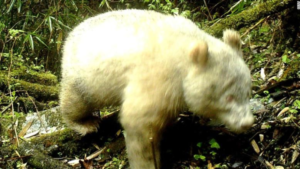
Caught on Camera: First ever Wild Albino Giant Panda seen in China’s Sichuan province
Recently, in China, an infra-red camera captured a rare fully albino Giant Panda roaming around the bamboo forests in the Sichuan Province, many experts believe that this is the first of its kind.
The picture of the fully albino giant panda was captured at the Wolong National Nature Reserve, which is located in the Sichuan province of China.
Experts believe that the wild albino panda is around 1 or 2-years-old, and this is also the first time that they have seen an albino panda roaming around freely.
The staff of the Wolong National Nature Reserve is currently setting up more cameras in the areas so they can see and capture better pictures of the extremely rare Panda.
A researcher from the Peking University, which is located in Beijing, Li Sheng said that “The panda looked strong and his steps were steady, a sign that the genetic mutation may not have quite impeded its life.”
In case you do not know what albinism is, it is a genetic mutation in an animal in which the animal lacks skin pigment or melanin.
Pandas are usually black and white, but the recently discovered panda is completely white, and this is not good, as it is at risk of getting seen in the wild easier.

It is known that albinism causes animals and even humans to have bad eye vision.
So why is this rare case very important?
Well, it is because of the threat that they may become extinct.
The International Union for Conservation of Nature, the giant panda is very fragile, and according to the World Wildlife Fund for Nature, there are only 1864 Giant Pandas left in the wild.
This just makes the wild giant albino panda more special and important.
The gender of the wild albino giant panda is still not determined, but one thing is for sure, and that is that the albino gene is currently present in the population of Pandas that live in the Wolong Nature Reserve in China.
Researchers at the China Conservation and Research Centre are going to monitor the area where the Giant Wild Albino Panda was seen and to see if the gene has been passed down.
The researchers at the China Conservation and Research Centre said, “If we can capture the next generation, the research value will be even greater.”